What's New
Displaying results 3841 - 3850 of 4052
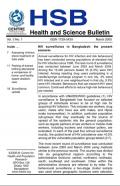
Resource | Publications,
Annual surveillance for HIV infection and risk behaviours has been conducted among populations at elevated risk for HIV infection since 1998. The last round of surveillance was conducted between June 2003 and March 2004. Among the 10,445 persons tested 35 (0.3%) were HIV infected. Among injecting drug users participating in a needle/syringe exchange program in one city, 4% were HIV infected and in one neighbourhood in that city, 8.9% were HIV infected. Behaviours that can transmit HIV were common. Continued efforts to reduce high-risk behaviours are needed.
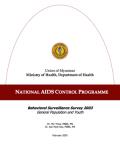
Resource | Publications,
A survey was undertaken during September–November 2003 to assess the knowledge, attitudes, and behaviours of the general population and the youth with regards to HIV/AIDS transmission and prevention at seven sites in Myanmar. A total of 9678 individuals (4631 males and 5047 females) were interviewed. Of these, 35% were youth aged 15–24 years.
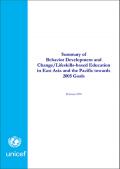
Resource | Publications,
Lifeskills-based education (LSBE) for HIV/AIDS and drug and substance use prevention in East Asia and the Pacific has been assessed by two methods. The first method of analysis was employed to compare LSBE programming in each country against the essential elements of behavior development and change (BDC) interventions. This method allows us to examine the evidence-base, appropriateness, quality, and sustainability of LSBE programming. The majority of countries are working to strengthen or expand elements of BDC that are in place or introduce new elements into their respective BDC/Lifeskills programs.

Resource | Publications,
In Asia and the Pacific at the end of 2004, the Joint United Nations Programme on HIV/AIDS (UNAIDS) estimates that 8.2 million people were living with HIV and the associated disease condition of AIDS, including 2.3 million women. This increased from 7.2 million in 2002 (women, 1.9 million). UNAIDS estimates that in 2004, 1.2 million people in the region became infected with HIV and 540,000 adults and children died from AIDS. The rapid increase of infections among women is particularly marked. In Cambodia, Myanmar, Papua New Guinea, Thailand, and several states of India the epidemic is firmly established in the general population. In other countries (e.g., People's Republic of China, Indonesia, and Viet Nam), low overall population prevalence rates disguise high, and rapidly growing, infection rates in specific population groups.
In 2002, Dr. Peter Piot, the Executive Director of UNAIDS, stated: "The epidemic in Asia threatens to become the largest in the world. With more than half the world's population, the region must treat AIDS as an issue of regional urgency. The question is no longer whether Asia and the Pacific will have a major epidemic, but rather how massive it will be." The goal for the Asian Development Bank (ADB) is to be an effective partner to its developing member countries (DMCs) in addressing this challenge.
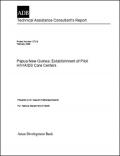
Resource | Publications,
The writers conducted several of site visits in Port Moresby, Lae, Mount Hagen and Rabaul including meeting, training and workshop. For a better caring, monitoring and evaluation of HIV/AIDS cases in the country, national guidelines for adult, children and pregnant women were developed together with the recording form and procurement system. The surveillance and post exposure prophylaxis reporting form and guidelines were revised and developed. The referral system was developed to strengthen HIV/AIDS care and increase drug adherence. The training for comprehensive HIV/AIDS care were set and given to the medical staffs in PMGH, 3 regional hospitals and NGOs.
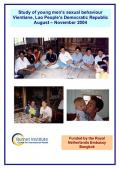
Resource | Publications,
Given that the spread of HIV throughout a community or a country is entirely contingent on human behaviour, we must acknowledge that public health interventions designed to prevent HIV transmission need to take account of the sexual practices of the relevant population. A more comprehensive approach would also consider other behaviours related to the spread of HIV - for example, behaviours around intravenous drug use and blood transfusions. The patterns of human sexuality within a population are generally considered to be culturally specific; as such, we need to evaluate societies individually if we wish to introduce public health measures for sexually transmitted infections (STI) that have both local relevance and local acceptance.
The Burnet Institute undertook a study of the sexual behaviour of young men in Vientiane from August to November in 2004. The study was funded by the Royal Netherlands Embassy in Bangkok.
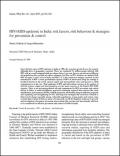
Resource | Publications,
Since the first report of HIV infection in India in 1986, the virus has spread all over the country although there is geographic variation. There are estimated 5.1 million people infected with HIV with an overall estimated adult prevalence below 1 per cent. Surveys carried out in different sub-populations have yielded prevalence estimates, but data on HIV incidence are limited. Both HIV serotypes 1 and 2 exist in India and HIV-1 C is the commonest subtype reported. Sexual transmission of HIV is most predominant. Spread of HIV in intravenous drug use settings is localized mostly in the north eastern region and metropolitan cities and parent to child transmission is on the rise. Dual epidemics of HIV and tuberculosis, increase in the number of infected women, stigma and discrimination are the main concerns in the Indian HIV/AIDS scenario.
There is an increasing political will and commitment for HIV prevention and control efforts in India. A multi-disciplinary approach combining targeted interventions like early identification and treatment of STDs, condom promotion, blood safety, drug de-addiction programs and expanding and strengthening VCTCs and long-term strategies like awareness oriented to behavioural change especially among vulnerable populations, young people and women, steps towards improvement of literacy, status of women and overall development, reduction in poverty and development of primary prevention interventions like vaccines and microbicides will have to be considered for effective prevention and control of AIDS in India.
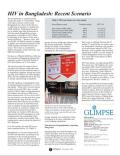
Resource | Publications,
World AIDS Day is commemorated around the globe on 1 December. Along with other countries of the world, Bangladesh also observed the Day by re-affirming its promise to confront the AIDS epidemic.
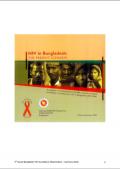
Resource | Publications,
Bangladesh is a low prevalence nation for HIV, and therefore, according to the guidelines of the Second Generation Surveillance system for HIV, surveillance should concentrate amongst selected groups of individuals who are known to be most at risk to HIV and some of the population groups that may bridge the epidemic into the general population. Therefore during all rounds of surveillance conducted so far in Bangladesh, including the fifth round, the population groups selected were confined to those considered to be most vulnerable and some bridging populations.
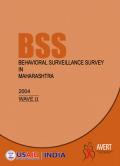
Resource | Publications,
The objective of the current BSS (Wave II) was to provide trends of behavioral indicators to inform program development for the expansion of interventions aimed at the reduction in the transmission of HIV/AIDS and Sexually Transmitted Infections (STIs) in the selected districts of Maharashtra.





